Did you get snow this weekend? It's been a weird return to winter pigging out and staying in all weekend, compared to the bike riding and long runs that R and I spent time doing LAST weekend.
So, as our trip to Colorado is nearly a month gone, I will reflect one last time about some of the non-Minnesotan critters we saw there. In Golden we spotted a strange black and white bird. Upon doing some research with K and JH, we figured out it was a Black Billed Magpie!
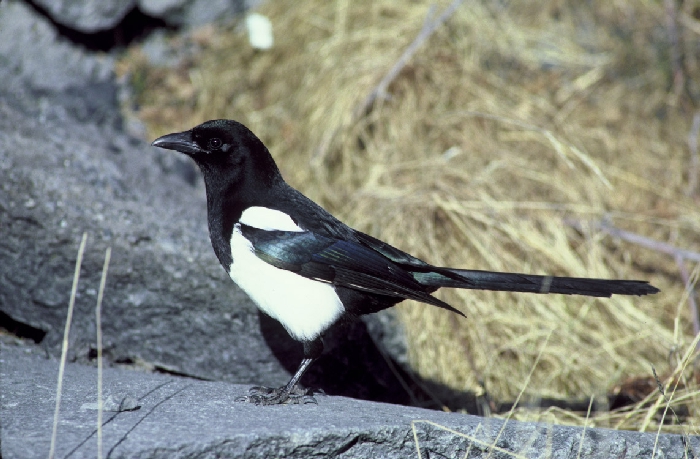
These Corvids, or members of the crow family, live from Alaska down to Oklahoma. They're about 18 inches long, with their long tails accounting for about half that length.
Pica hudsonia pairs live together year-round, and March through July is breeding season. While the female bird only incubates her four to eight eggs for 16 to 18 days, the magpies spend up to 50 days building their nest! Measuring 48 to 90 inches across, magpie nests are hooded and feature several side entrances. Hawks and owls sometimes steal magpie nests for their own use!

Magpies enjoy eating a variety of foods, including carrion, bugs, fruit, nuts and seeds. They have a reputation from stealing baby birds from nests, as well as snatching food from other birds. Magpies also will alight on big animals like moose and deer to pick wood ticks from their coats. The black billed magpies will often hoard the live ticks in a hiding place, which backfires as the bugs are still alive and escape from the hiding spot!

I hope you've learned a little about these lovely birds! Apparently their winter territory includes Western Minnesota, so maybe we'll see some soon after all.
On our mountain drive to Salida, several mule deer ambled across the road in front of our car! They seemed quite nonchalant about the danger. The funniest sighting was when JB and JF were driving us to the hot springs; about 20 deer were surrounding a church and eating the shrubbery! Unfortunately we didn't have our camera.
Here is my deer entry from my old site, circa 11/16/2005:
This weekend my sister A and I were chatting about deer. Sis A said, "Wendell, just write that the deer are running crazy all over the place." (She hit one last month). Her sweetie TG [now husband] was there and he mentioned a friend of his had been in Texas hunting something called "Axis deer". You know my interest was piqued!
So, back to deer. Scientists believe that deer moved down from the Arctic Circle about four million years ago, populating the warmer southern regions of Europe, Asia and North America. These animals are members of the Order Artiodactyla, or "even-toed ungulates", (even though some peccaries have three toes?) This order includes the aforementioned peccaries, piggies, cows, antelope and deer.
The most widespread species in the US is the whitetail deer, Odocoileus virginianus. There are 30 subspecies and eight different varieties of deer in the Americas.
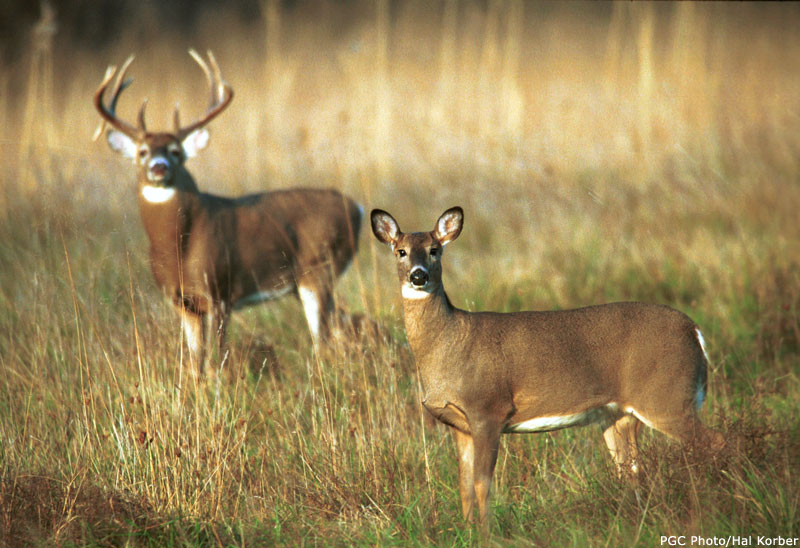
I'm sure you've seen the whitetail deer, hopefully not running in front of your vehicle! They are tan to reddish or grayish tan, with white undersides. And of course, the white tail, which becomes visible when a startled deer lifts it, or while running away from an enemy.
Most often you will see deer at dusk or before sunrise. During the day they usually bed down and rest, and then awaken to feed through the night. They will also lie down to rest and chew cud in the night.
Whitetails are known to eat up to 500 varieties of plants in the US. Depending on their habitats, deer will either graze on grasses or forage for leaves and bark; usually a combination of both. In food-rich habitats, deer won't travel far, but obviously will have a larger home range if nourishment is scarce. It requires seven deer to eat as much as one cow.
Whitetails have antlers, which act as protection, a way to mark their territory, and as a fighting tool for the rut! Apparently antler production is related to TESTICULAR ACTIVITY! (Yes!) In the spring, male deer aren't sexually active, and antlers form. As the sexual glands grow during the summer, the antlers harden and lose their velvet. After the bucks mate, the antlers fall off. (My parents then try to find these "sheds".)
Contrary to popular belief, the amount of points on a deer's antlers does not show the age of the animal. Instead, antler size is mostly determined by how much food the deer eats through the spring and summer. (Although older deer will have thicker antler bases.) The best way to determine the age of the deer is by examining their teeth. Apparently antler size is affected by geography (and I wonder if that's related to nutrition too?)
Also whitetail antler size is usually larger if my Dad and his hunting buddies (which includes the S family, my uncles and cousins, and two of my sisters) are shooting them! We have five 10-pointers in our living room at home. At Christmas my Dad likes to hang jewelry for my Mom from the deer antlers! This has included diamond earrings, necklaces, and even her wedding ring after he'd replaced the long lost diamond!
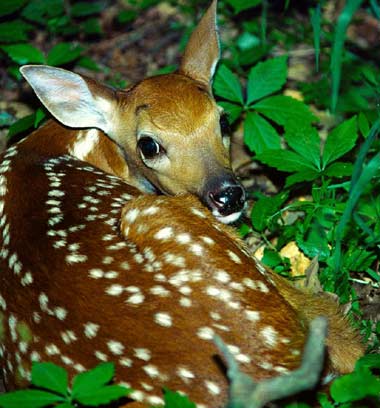
Ok, back to the nooky! The rut takes place from Sept. to early Dec., depending on the climate of the region. The bucks necks swell, and they start fighting to win the doe's attention. The gestation period for deer is seven months, and the doe will hide the newborn fawn for ten days to two weeks, returning throughout the day to nurse it. The spots on the fawn are designed to help it remain invisible in the dappled sunlight of forest underbrush. Eventually the fawn will start walking more strongly and follow her around. Occasionally deer will mate in their first year of life, if food is abundant, but most often lovemaking occurs at the two year mark.
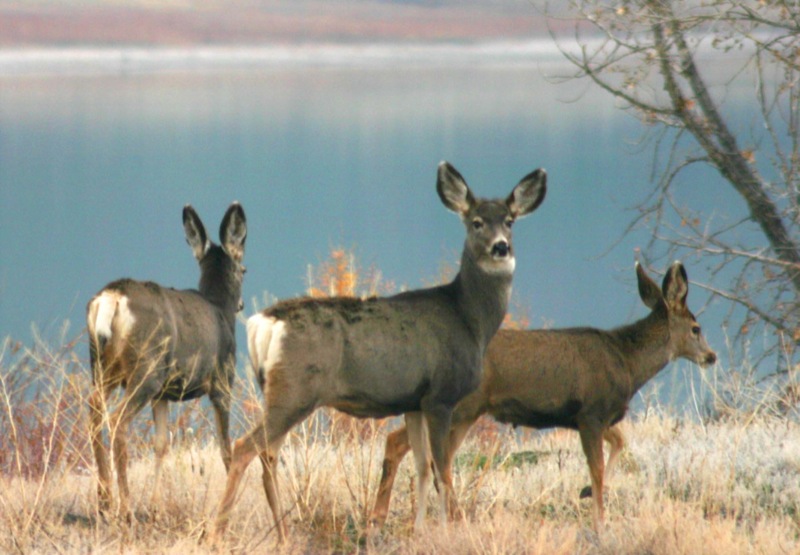
Mule deer (Ococoileus hemionus) are also found in the United States. It seems they prefer more southern and western climates. These large-eared deer sort of hop along, and leave four footprints at once! Mulies and whitetails can interbreed, and these hybrids most resemble whitetails. A variety of mule deer is the blacktailed deer. Here is a male muley; note the black tipped ears.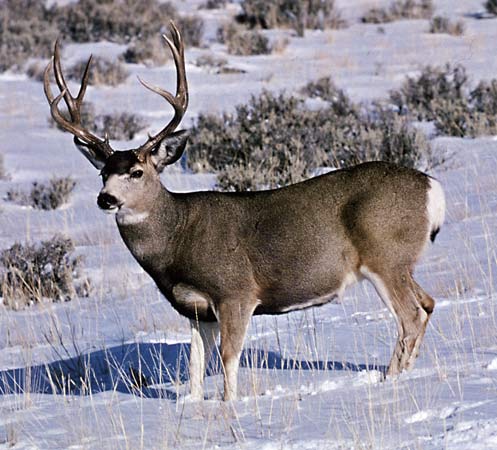
Now on to T's Axis deer. It's true! In 1932 axis deer (Cerus axix) were imported from India to Texas! In their native land they are referred to as chital. These large deer are spotted even in adulthood, have three spikes on their antlers (with one being much longer than the other two) and have a dark stripe running down their spotted backs!
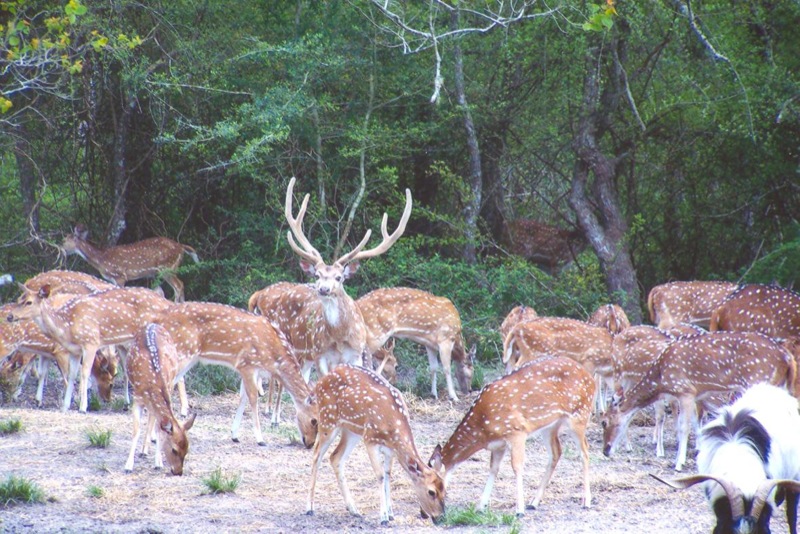
As you can see, axis deer resemble elk, and like that species, bugle during mating displays. Unlike mule deer and whitetails, axis deer mate throughout the year, and males shed their antlers accordingly. Even so, most babies are born between January and April.
So there is your refresher course on deer! R and I did spot some antelope on our drive back, but, I don't want to make your brain explode with too much information!
Hope your weeks start off smoovly!
xoxo
Wendell!

No comments:
Post a Comment